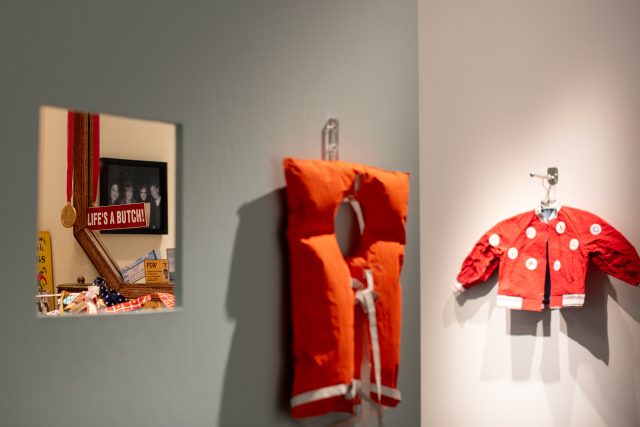[ad_1]
For the next month, the University of Michigan Institute for the Humanities will feature the work of Jewish lesbian artist Phranc, whose exhibit “The Butch Closet” features posters, magazines, memorabilia and clothes made out of cardboard recreate Phranc’s childhood closet.
The multi-media exhibit, which opened Thursday, details Phranc’s life as a Queer artist and includes recreations of Phranc’s personal objects and clothing made of paper, cardboard, thread and paint. The model closet is meant to explore the personal clothing items that were very special to Phranc as she grew to find her butch identity — a term often used to refer to lesbians with masculine presenting features and dress.
In an interview with The Michigan Daily, Phranc said the use of the closet was meant to show the importance of these clothes in her life, but also to reclaim the term “closet” in a Queer setting.
“The literal and the figurative closet, which is usually seen as a place of restraint and Queer hiding, I’m reclaiming that by opening it up and letting you see how I’ve become me,” Phranc said. “So it’s really kind of more of a coming-out closet than it’s a hiding closet. There’s windows on the sides so you can see all the personal objects. There’s also a mirror in the closet so you can see yourself.”
Phranc worked in collaboration with the Institute to bring this exhibit to life. Amanda Krugliak, arts curator and assistant director of creative programming at the Institute, said in an interview with The Daily she hopes the exhibit will provide more visibility to Queer stories.
“A show like this, for me, is really giving visibility to Phranc and Phranc’s story, and also connecting past and the present, showing this incredible history of feminism and queer activism, and putting that all in your context that is also accessible to people,” Krugliak said. “Part of me wants students to know that they’re part of this lineage of women who are standing up for their rights and are powerful and empowered, and that our greatest superpower really is being true to ourselves.”
Art & Design freshman Victoria Selektor said she was impressed with the craftsmanship on many of the pieces. Selektor also said she was happy to see the closet itself and the part it played in telling Phranc’s story.
“It takes a very high level of craftsmanship to be able to sew paper, because sewing is already difficult, but doing it with paper is sometimes more difficult,” Selektor said. “I also really liked how she had the closet open where it’s like the opposite of what it usually is, and it’s supposed to be inviting into her story.”
Phranc said the purpose of her exhibition is to create a sense of nostalgia within visitors, who can hopefully connect their own stories to the pieces.
“I always hope that somebody has an identification with me,” Phranc said. “The most thrilling thing is when somebody walks through and goes, ‘I had that,’ ‘I remember that,’ and it triggers a memory of their own, so it becomes personal to them, which is great because the work is so personal to me. … All of my memories aren’t positive with all of these objects, but the objects themselves are the victory.”
The pieces in the closet reflect an array of memories from Phranc’s life. One item showcased in the closet is a cardboard graphic T-shirt that says “Seattle.” According to the exhibit description, Phranc wore the Seattle T-shirt often when she went to visit her grandparents. While they previously had a close relationship, when Phranc came out to them, they refused to see her. As the years went by, the grandparents’ mood softened and they were able to reconnect. To Phranc, the T-shirt is a reminder of the love they all once shared. Krugliak said the T-shirt stood out to her most because of its connection to Phranc’s grandparents.
“That little T-shirt of the Seattle fair and the story behind that, of being with her grandparents and feeling so loved before she came out, and holding on to that memory is really moving for me,” Krugliak said.
Selektor said she was drawn to a plaid blue jacket, also made of cardboard, because she could relate to the idea of a clothing piece providing a sense of security.
“I really liked the blue jacket, because in her presentation she talks about how much it meant to her and how each person has their own type of blue jacket,” Selektor said. “An item or a symbol to them that is theirs and makes them feel safe.”
Art & Design junior Tori Lynch said it was inspiring to see and connect with the work of a Queer artist, particularly an older one.
“As a transmasc person and an artist myself, it’s just so wonderful to see this and just to see Phranc’s history,” Lynch said. “It’s really nice to see older Queer people and their work and it shows you what you can be in the future.”
Phranc said she shares this sentiment about representation, paying homage both to generations of Queer people that came before her and the example she can be to the younger Queer community.
“When I came out, 17, being a butch was not cool,” Phranc said. “It was very much underappreciated. It’s now that we’re reclaiming our Queer and our gay and lesbian history, and we’re starting to acknowledge butch and reclaim it.”
Daily Staff Reporter Audrey Shabelski can be reached at audres@umich.edu.
Related articles
[ad_2]
Source link











